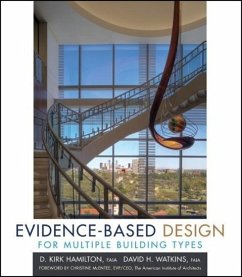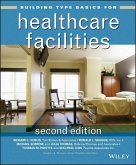"D. Kirk Hamilton, FAIA, and David H. Watkins, FAIA, have written this enlightening book showcasing the process and products of evidence-based design, a practice that should be in the top drawer of every architect's toolkit. Evidence-based design sounds a clarion call for more rigor in the knowledge-based practice of creating the built environment, as well as stronger collaboration and sharing of knowledge between client and designer. I can't think of two people more qualified to have taken on this topic."
- From the Foreword by Christine McEntee, Executive Vice President/CEO, The American Institute of Architects
Gain a competitive advantage
from research-based design
Evidence-based design enables architects and their clients to optimize design decisions via a process of gathering, evaluating, and applying current best evidence from research and practice. Written by leading experts in the field of evidence-based design, this book guides the reader through the complete process, culminating in the creation of high-performance environments, including:
Locating the best available evidence from a variety of fields and sources
Creating meaningful collaborations with clients and users for decision making
Recognizing and responding to the unique context of each project
Using critical thinking to interpret the implications of research
Establishing a strong chain of logic that links research findings to design
In addition to providing general guidelines for the evidence-based design process, the authors describe how the process is applied in the design of specific building types, including hospitals, schools, offices, retail stores, and performance spaces. Throughout the book, examples underscore the effectiveness of credible research to support evidence-based design decisions. Moreover, comprehensive case studies are presented for each building type, demonstrating, for example, how design impacts a worker's productivity and efficiency or a student's ability to learn and achieve.
Following the authors' advice, architects, interior designers, facility managers, and related professionals will learn to create better, more effective designs by moving from an approach based on intuition and anecdotal information to one solidly based on evidence and outcomes.
- From the Foreword by Christine McEntee, Executive Vice President/CEO, The American Institute of Architects
Gain a competitive advantage
from research-based design
Evidence-based design enables architects and their clients to optimize design decisions via a process of gathering, evaluating, and applying current best evidence from research and practice. Written by leading experts in the field of evidence-based design, this book guides the reader through the complete process, culminating in the creation of high-performance environments, including:
Locating the best available evidence from a variety of fields and sources
Creating meaningful collaborations with clients and users for decision making
Recognizing and responding to the unique context of each project
Using critical thinking to interpret the implications of research
Establishing a strong chain of logic that links research findings to design
In addition to providing general guidelines for the evidence-based design process, the authors describe how the process is applied in the design of specific building types, including hospitals, schools, offices, retail stores, and performance spaces. Throughout the book, examples underscore the effectiveness of credible research to support evidence-based design decisions. Moreover, comprehensive case studies are presented for each building type, demonstrating, for example, how design impacts a worker's productivity and efficiency or a student's ability to learn and achieve.
Following the authors' advice, architects, interior designers, facility managers, and related professionals will learn to create better, more effective designs by moving from an approach based on intuition and anecdotal information to one solidly based on evidence and outcomes.








